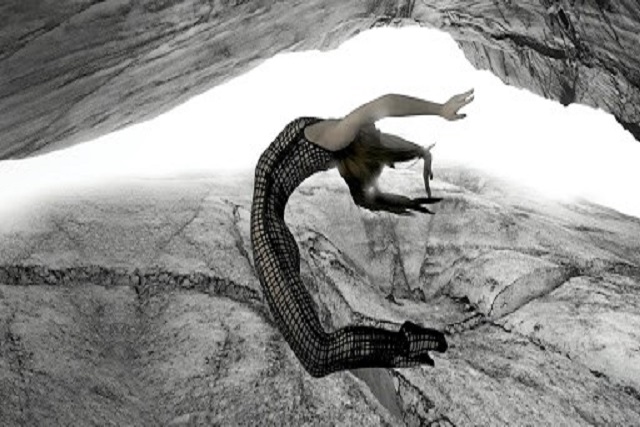Stills from Nirma Madhoo’s new-media fashion film ‘Labtayt Sulci’ Nirma Madhoo’s work explores how fashion environments are shaped by digital tools. She creates fashion films – a cinematographer’s vision, stylised and experimental. As a marketing tool to show a designer’s clothes in motion, fashion films aim for a softer sell than adverts and target niche audiences.
Her latest fashion film, Labtayt Sulci, showed at this year’s Berlin Fashion Film Festival. It combines natural and digital landscapes to create a dreamy, “otherworldly” experience with a futuristic and surrealistic feel. The usually graceful bodies of the models are transformed into her film into glitchy, staccato robots.But Madhoo maintains a softness and humanness in them, too. Her work is informed by post-humanist and futurist thinking and aesthetics.
Describing herself as “culturally hybrid” and as an “accidental nomad”, Mauritian-born Madhoo moved to South Africa in 1998. She travelled between the UK and South Africa for two years, studying fashion photography and filmmaking. She’s now in Durban.
How did you combine the fashion and the digital fields? I trained as a fashion designer at Durban University of Technology (DUT) and did the young designer ”thing” for a while before lecturing fashion theory in 2007. In 2013 I took a sabbatical to train as a fashion photographer and fashion filmmaker at the London College of Fashion (LCF).
My interest in the digital stems from my upbringing – my father, who was a science teacher, got the family one of the first personal computers, the ZX Spectrum. I grew up surrounded by cameras and gadgets. I think these were formative in who I became although my passion for the digital only crystallised when I undertook my second Masters at LCF – an institution spearheading research in digital fashion.
How did you get into making fashion films? My first Masters at DUT researched aspects of construction of the fashion image so the interest was always there. The trigger was watching fashion films broadcast via digital platforms such as SHOWstudio in 2010. I realised there was something new and exciting that was happening in the fashion world and I wanted to be part of it.
How do you get work seen? The fashion film world is open and accessible to anyone with a cellphone and internet connection. Submitting work to fashion film festivals is easy from anywhere in the world. The LCF network is especially supportive of its alumni and I’m slowly developing a network in South Africa where there are small circuits of progressive thinking. Johannesburg is at the forefront of this, especially in terms of the digital sphere.
Your fashion films ‘Future Body’ and ‘Labtayt Sulci’ have a similar look in terms of the colours used and the kind of flow created through your direction and music. Do you have a specific style? I try to explore a particular sensibility and aesthetic that will hopefully become something of a signature across my portfolio. Having trained in fashion, I understand it well. I have a definite idea of how the productions that I’m now conceptualising and directing should look and feel.
I try to embed a futuristic feel and to create fashion identities which are an alternative, but at the same time easy for a wide audience to relate to. You say that ‘Future Body’ was about exploring ‘discourses of the future and digital aesthetics’ Could you please expand on this? Our age is defined by technological changes in the same way the Age of the Machine in the 1920s/30s engendered a new aesthetic and design language that defined the fashion of that era. My work interrogates the way we conceptualise fashion and fashion identities in environments shaped by technology.
Fashion media has become about interactivity with technologies like virtual reality, augmented reality and mixed reality. Fashion has never been just about the clothes on our bodies; it’s always been about ways of being, taking us to different places and different times. With new media tools, these capabilities are augmented.
Your latest fashion film ‘Labtayt Sulci’ showed at the Berlin Fashion Film Festival last month. Where else have you shown films? At London Short Film Festival and Aesthetica Short Film Festival (UK); also Melbourne Fashion Festival along with artists such as Bart Hess and Hussein Chalayan whose work I look to for inspiration.
Explain ‘Labtayt Sulci’? The film is inspired by Nasa’s explorations of Saturn’s moons by the Cassini expedition. Digital renderings of Enceladus are of evocative ice-blue textured surfaces.
There are accounts of an icy crust over a warm ocean that may hold extraterrestrial life. These images are digitally rendered, not entirely realistic, but they captured my imagination.
How do your films explore post-humanist and futurist thinking? As a consumer of fashion images I became tired of the normative sexualised or decorative roles that women have in mainstream fashion editorials.I’m interested in science fiction as a genre, so fashion identities in my projects hinge on the idea of a cyborgian or exobiological other – hybrid identities that are both human and machine. “Tech” and “space” are usually seen as masculine fields. I use fiction, speculation and futurism to challenge this.
Current project? A multimedia project that looks at (pan-)African digital identity and futurism. – bubblegumclub
This article was originally published in The Times. (http://wantedonline.co.za/style/fashion/2017-07-24-durban-based-nirma-madhoo-takes-fashion-into-new-era/)
Image: Supplied: A still from Nirma Madhoo’s fashion film ‘Labtayt Sulci’


